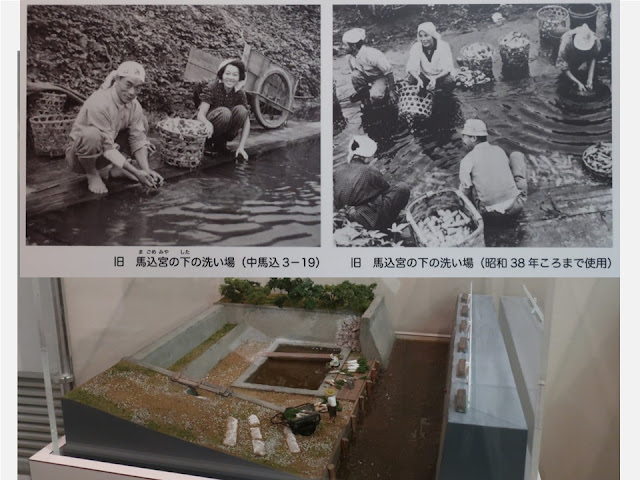Ota is one of 23 wards of Tokyo, which is in the southern part of Tokyo. The most attractive exhibit for me was Fuji-kou; it is a religious group which worships the deity of Mt. Fuji.
東京都南部、神奈川県との境の大田区の歴史と民俗を紹介しています。玄関ホールの富士講が実物と共に人々の活動を紹介していて印象的でした。
Special exhibition “Fuji-kou in Haneda”、特集展示「羽田の富士講」
Worship of devout pilgrims on sacred Fuji, making the round of the crater, Japan (1905) https://www.loc.gov/item/2020684877/
The small exhibition was held in 2022. In
the Edo period
(1603~1868), Edo (old name of Tokyo) people formed a kou which had 50 to 200 members,
and went to Mt. Fuji. (Reference: Life in Edo, old Tokyo (published in 1959),
Chapter 7: Daily lives, (1)Seasonal recreation). Many people did it until the
end of the 19th century. Donations from a kou in Haneda
(Konohana-kou) were main exhibits.
2022年4月から7月までの特集展示です。江戸時代には、山開きの6月1日(旧暦)に、50人から200人で講を組み、江戸の街から富士山に向かったといいます(ご参考: 江戸生活事典、7章風俗概要、(1) 遊楽)。明治中期までは盛んでした。ここでは、羽田の富士講であった木花講の寄贈品を中心に紹介されています。
A miniature of Mt. Fuji was built in Haneda Shrine in the middle of the 19th century. It is called “Haneda Fuji”; you can climb it.
羽田神社の境内には、明治初年に富士講によって富士塚が築造されました。「羽田富士」と呼ばれ、登拝できます。
The coat was used to climb Mt. Fuji. It was a custom not to wash it and to use it carefully. There are many signatures and stamps on it, which shows how many time the owner went to Mt. Fuji. So, a plain white coat means the owner is a beginner. They were proud of the messy coat.
富士講は白装束ですが、行衣は大変汚れています。洗わずに大切に使用するのが慣わしで、縫い付けた御朱印や版木の跡がたくさん残っています。印が多いほど、経験豊かな行者であることを示します。
The members of the Fuji-kou have a party in January, May and September. They gather at a house in-duty in the evening and pray in order to drive a disease and a disaster away. They hang three scrolls on the wall and chant.
富士講では、富士登拝だけでなく、正月、五月、九月の夜に当番の家で、「御焚き上げ」(月拝み)を行い、病気や災厄を払います。当番の家に、「御焚上用箱」を持ち込み、線香を焚きます。床の間には、「御三福」という掛け軸をかけ、「お伝え」という経本を唱えました。
Ritual equipment: the box for incense (copperware) was made in 1933.
御焚上の用具です。御焚上用箱は、1933年に作られた銅製の箱です。
Hereditary sutra book、「お伝え」と呼ばれる経本
The banner was used while climbing, praying and so on. It was considered to be used until 1980s.
登山や奉納などの際に用いられた布マネキ。昭和50年代後半まで使われたと想定されています。
Permanent exhibition、常設展
Ota is a flourish city area, but it was a suburb of the central Tokyo. The kite below the ceiling and the equipment behind are used in traditional events. In Gonjouji (temple), people wear the outfits and perform “Suishi-mai”, or literary the dance to stop raining. In the early 15th century, people prayed for rain. It worked, but it continued raining, so they started “Suishi-mai”. It is held at Bon in summer.
Since the late 19th century, Ota had prospered as a vegetable center of Tokyo. At Haneda, fishing and seaweed farming were prospered. Inns in Omori were also prospered; it was between Shinagawa and Kawasaki which were official post towns in the Edo period (1603~1868).
天井面に「六郷とんび凧」(成人の日の行事)、床面には大田区の地図、奥には大森厳正寺の水止舞の装束が展示されています。15世紀前半に、雨乞い後に、雨が止まなくなったので行った水止めの舞で、今も、お盆に行われています。
大田区は豊かな田園地帯でしたが、明治中期から東京へ向けた野菜生産が盛んになりました。また、羽田浦の漁業、大森ののりの養殖も盛んでした。大森は、品川宿と川崎宿の間(あい)の宿として大変賑わったそうです。
They removed mud of vegetables at the irrigation channel. It’s a good place for chatting. In 1935, half of vegetables which were consumed in Tokyo were supplied from Ota region.
模型は、六郷用水沿いの野菜洗い場。出荷する野菜の泥を落としました。会話の場ですね。昭和10年、東京都区内の野菜の出荷の半分は大田・品川区域が占めました。
Ota was not only a good fishing area at Tokyo Bay, but also a river fishing place at Tama River. Fishermen caught ayu fishes, cooked them and served to visitors on a boat. It was popular.
東京湾での海苔の養殖や貝の漁だけでなく、多摩川では鮎が名高く、屋形船で捕りたての鮎を提供する「川狩」が流行ったそうです。
At Tama River, sand and gravel were dredged. Those were brought to Yokosuka, Chiba and so on. It was a hard work; they sang a work song, I’m sure. It was prohibited in 1964, because seawater flew into the river easily.
多摩川では砂利や砂が採掘され、砂利船(写真は昭和初期)から荷足(にたり)船(右の模型)に載せられて、横須賀や千葉までも運ばれ、建築材料や敷石に使われたそうです。労働歌が聞こえてきそうですね。1964年に、川底の低下によって海水が川に流入するなどの問題が生じ、多摩川(青梅から河口)の砂利採取は禁止されました。
The history kept in the ground、地中に刻まれた歴史
Excavated artifacts which were made until the medieval era are displayed.
中世までの出土物が展示されています。
The model of the ancient house (around 7th century) is small but is elaborate. The flued cooking stove was a characteristic one of Ota.
古墳時代後期(7世紀ごろ)の竪穴住居の模型。小さいですが、人々の生活が丁寧に再現されています。煙道が長いカマドが大田区の特徴だそうです。
Modernization and urbanization、近代化とまち
Shochiku (a movie company) had a studio in Kamata of Ota.
松竹キネマ・蒲田撮影所の模型が展示されています。田中絹代さんらが活躍した時代です。1936年に大船へ移転しました。
Children in 1950s were not so rich but so energetic.
昭和30年頃の子供たち。エネルギーを感じます。
The photo at upper left is a Bon Festival dance at Honmonji (temple) in 1966. The radio calisthenics (lower right) was broadcasted nationwide in 1953. Energetic people and smoke from factories and remind me of the Showa period (1926-1989).
本門寺の盆踊り(1966)と全国中継されたラジオ体操会(1953)。煙突からの煙、人々のエネルギー、昭和です。
Visited in April, 2022
Official website: https://www.city.ota.tokyo.jp/seikatsu/manabu/hakubutsukan/index.html
(in Japanese), accessed in February, 2023
Previous post (tiny museum in Tokyo and sumo arena): Acupuncture treatment and
massage museum in Ryogoku sumo wrestling district、鍼灸あん摩博物館と両国国技館
Next post (museum in Tokyo): Bunkyo Museum、文京ふるさと歴史館


















Comments
Post a Comment